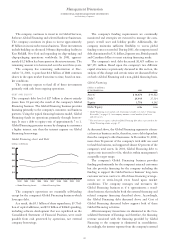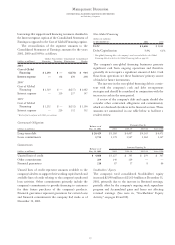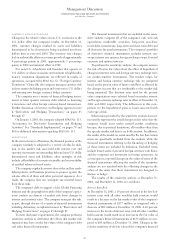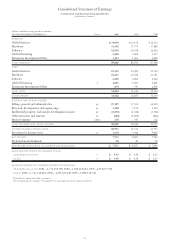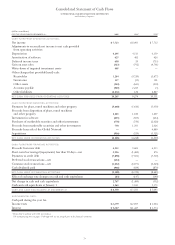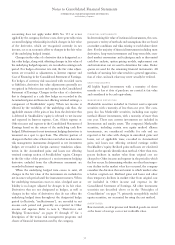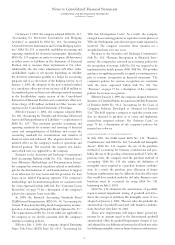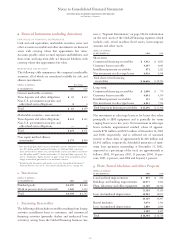IBM 2001 Annual Report Download - page 77
Download and view the complete annual report
Please find page 77 of the 2001 IBM annual report below. You can navigate through the pages in the report by either clicking on the pages listed below, or by using the keyword search tool below to find specific information within the annual report.
Notes to Consolidated Financial Statements
INTERNATIONAL BUSINESS MACHINES CORPORATION
and Subsidiary Companies
75
aSignificant Accounting Policies
PRINCIPLES OF CONSOLIDATION
The consolidated financial statements include the accounts
of International Business Machines Corporation and its con-
trolled subsidiary companies, which in general are majority
owned. Investments in business entities in which the com-
pany does not have control, but has the ability to exercise
significant influence over operating and financial policies
(generally 20-50 percent ownership), are accounted for by
the equity method. Other investments are accounted for
by the cost method. The accounting policy for other invest-
ments in securities is described on page 78 within
“Marketable Securities.”
USE OF ESTIMATES
The preparation of financial statements in conformity with
generally accepted accounting principles requires manage-
ment to make estimates and assumptions that affect the
amounts that are reported in the consolidated financial state-
ments and accompanying disclosures. Although these
estimates are based on management’s best knowledge of cur-
rent events and actions that the company may undertake in
the future, actual results may be different from the estimates.
REVENUE
The company recognizes revenue when it is realized or real-
izable and earned. The company considers revenue realized
or realizable and earned when it has persuasive evidence of
an arrangement, the product has been shipped or the services
have been provided to the customer, the sales price is fixed
or determinable and collectibility is reasonably assured. The
company reduces revenue for estimated customer returns
and other allowances. In addition to the aforementioned
general policy, the following are the specific revenue recog-
nition policies for each major category of revenue and for
multiple element arrangements.
Services
The terms of service contracts generally range from less
than one year up to ten years. Revenue from time and mate-
rial service contracts is recognized as the services are
provided. Revenue from Strategic Outsourcing Service con-
tracts reflects the extent of actual services delivered in the
period in accordance with the terms of the contract.
Revenue from Business Innovation Services (BIS) contracts
requiring the delivery of unique products and/or services is
recognized using the percentage-of-completion (POC)
method of accounting. In using the POC method, the com-
pany records revenue by reference to the costs incurred to
date and the estimated costs remaining to fulfill the con-
tracts. Provisions for losses are recognized during the period
in which the loss first becomes apparent. Revenue from
maintenance is recognized over the contractual period or as
the services are performed.
In some of the company’s services contracts, the com-
pany bills the customer prior to performing the service.
This situation gives rise to deferred income of $2.4 billion
and $2.5 billion at December 31, 2001 and 2000, respectively,
included in Deferred income on the Consolidated Statement
of Financial Position. In other services contracts, the company
performs the service prior to billing the customer. This situa-
tion gives rise to unbilled accounts receivable of $1.3 billion
and $1.2 billion at December 31, 2001 and 2000, respectively,
included in Notes and accounts receivable
—
trade on the
Consolidated Statement of Financial Position. In these
circumstances, billings usually occur shortly after the com-
pany performs the services and can range up to six months
later. Unbilled receivables are expected to be billed and col-
lected within nine months.
Hardware
Revenue from hardware sales or sales-type leases is recog-
nized when the product is shipped to the customer and there
are no unfulfilled company obligations that affect the cus-
tomer’s final acceptance of the arrangement. Any cost of
these obligations is accrued when the corresponding revenue
is recognized. Revenue from rentals and operating leases is
recognized monthly as the fees accrue.
Software
Revenue from one-time charge licensed software is recognized
at the inception of the license term. Revenue from monthly
software licenses is recognized ratably over the license term.
Revenue from maintenance, unspecified upgrades and tech-
nical support is recognized over the period such items are
delivered. See “Multiple Element Arrangements” below for
further information.
Financing
Revenue from financing is recognized at level rates of return
over the term of the lease or receivable.
Multiple Element Arrangements
The company enters into transactions that include multiple
element arrangements, which may include any combination
of hardware, services or software. These arrangements and
stand-alone software arrangements may also involve any com-
bination of software maintenance, software technical support
or unspecified software upgrades. When some elements are



